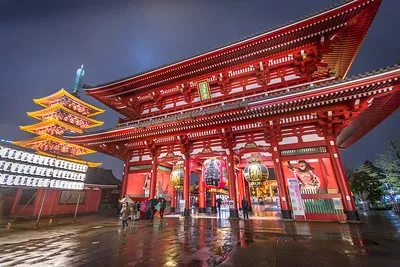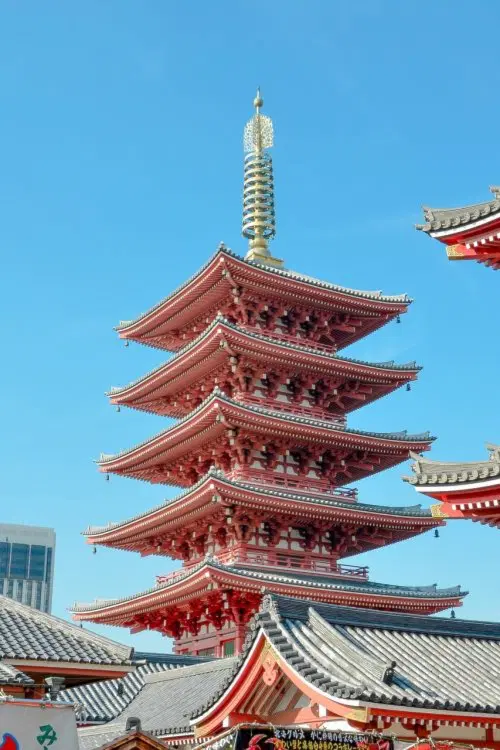Sensoji Temple, also known as Asakusa Kannon Temple, stands as the oldest and most renowned Buddhist temple in Japan, drawing in over 30 million visitors each year. Its striking red gates, lively shopping streets, and deep-rooted history make it an essential stop for anyone journeying through Tokyo.
Nestled in the heart of Asakusa, this remarkable temple offers a unique glimpse into Japan’s vibrant culture and heritage. Whether you’re visiting for the first time or returning as a seasoned explorer, this guide will ensure you fully enjoy your experience at Sensoji Temple.

The History & Legend of Sensoji Temple
Sensoji Temple, often referred to as Asakusa Kannon Temple, holds the title of Tokyo’s oldest temple, established in 645 AD. The legend tells of two brothers, Hinokuma Hamanari and Hinokuma Takenari, who discovered a statue of Kannon, the goddess of mercy, in the Sumida River in 628 AD.
Despite their attempts to return the statue to the river, it persistently reappeared to them. Understanding its importance, the village chief, Hajino Nakamoto, constructed a modest temple to enshrine the statue.
The original temple was completed in 645 AD, marking it as Tokyo’s oldest religious site. Over the years, Sensoji Temple gained prominence, evolving into a significant hub for Buddhist worship.
During the Edo period (1603-1868), the temple’s status soared as Tokugawa Ieyasu, the inaugural Tokugawa shogun, appointed it as the clan’s protective temple.
Tragically, Sensoji Temple was devastated during a firebombing raid in Tokyo in 1945. The main hall was reconstructed between 1951 and 1958, symbolizing renewal and tranquility. The current structures, including the iconic Kaminarimon Gate and Hozomon Gate, were rebuilt in the 1960s.
Culturally, Sensoji Temple serves as more than just a spiritual site; it is a vibrant landmark. The temple grounds feature Nakamise Shopping Street, a lively avenue filled with shops offering traditional Japanese crafts and snacks. Additionally, it hosts the lively Sanja Matsuri festival every May, one of Tokyo’s most vibrant and colorful events.
Architectural Highlights of Sensoji Temple
Sensoji Temple features several notable architectural highlights:
Kaminarimon (Thunder Gate)
The Kaminarimon, or Thunder Gate, is the grand entrance to Sensoji Temple. It’s one of the most iconic structures in Tokyo. The gate features a massive red lantern, which is 3.9 meters tall and weighs 700 kilograms. Two large statues guard the gate: Fujin, the god of wind, and Raijin, the god of thunder. These statues bring protection and good fortune to the temple.
Nakamise Street
Before you reach the temple, you’ll walk through Nakamise Street, a bustling shopping street that’s about 250 meters long. The street is lined with over 80 shops selling traditional Japanese snacks, souvenirs, and handmade crafts. It’s a great place to try local treats like ningyo-yaki (small cakes filled with sweet bean paste) and senbei (crispy rice crackers).
Hozomon Gate
The Hozomon Gate is the second large gate leading to the main hall of Sensoji Temple. This impressive structure has two levels and houses important Buddhist artifacts. Inside, you’ll find treasures and a pair of giant guardian statues. The gate is adorned with beautiful carvings and decorations, adding to its grandeur.
Main Hall (Kannon-do)
The Main Hall, also known as Kannon-do, is the most important part of Sensoji Temple. Inside, you’ll find a golden statue of **Kannon**, the goddess of mercy. The hall is beautifully decorated with wooden carvings and colorful details. It’s a peaceful place where visitors come to pray and seek blessings.

Five-Story Pagoda
Near the Main Hall stands the Five-Story Pagoda, a tall and beautiful structure that’s one of the most famous pagodas in Japan. The pagoda is 53 meters (174 feet) tall and represents Buddhist teachings.
While it’s not open to visitors, it’s amazing to see from the outside, especially when it’s lit up at night.
The original pagoda was built in 942 AD. It was one of the “Four Edo Pagodas” during the Edo period (1603-1868), along with the pagodas of Kan-eiji, Ikegami Honmonji, and Shiba Zojoji. These pagodas were considered symbols of protection and prosperity for the city.
Unfortunately, the original pagoda was destroyed during an air raid in World War II. After the war, it was rebuilt at its current location in 1973. The new pagoda was designed to maintain the traditional architectural style while incorporating modern materials for better durability.
The top floor houses Buddha’s ashes, which were officially inherited from the Isurumuniya temple in Sri Lanka. The pagoda serves as a place for spiritual reflection and reverence.
How to Get to Sensoji Temple
Sensoji Temple is easy to reach by public transport:
By Train: Take the Tokyo Metro Ginza Line, Toei Asakusa Line, or Tobu Skytree Line to Asakusa Station. The temple is a 5-minute walk from the station.
By Bus: Several city buses stop near Asakusa.
By Water Bus: You can also take a Sumida River cruise to Asakusa.
Wear comfortable shoes as you will walk a lot.
Try the local food at Nakamise Street.
Respect the customs (e.g., cleanse your hands at the purification fountain before entering the temple).
Take photos, but avoid using flash inside the temple.
Best Times to Visit
The best times to visit Sensoji Temple are during the spring (late March to early April) and autumn (September to November). During these seasons, the weather is pleasant, and you can enjoy the beautiful cherry blossoms in spring and colorful foliage in autumn. Early mornings and late evenings are ideal times to visit to avoid the crowds.
Free Entry: No tickets needed for the temple grounds.
Accommodation
Staying near Sensoji Temple is convenient for tourists, with options ranging from budget hostels to luxury hotels. The Asakusa area itself offers numerous lodging choices that cater to all budgets.
Final Thoughts
Sensoji Temple is not just a historical monument or a place of worship, but a living testament to Tokyo’s rich history, resilience, and enduring spirit. The temple’s legendary origins, architectural grandeur, and cultural significance weave a fascinating tapestry of stories that continue to captivate visitors from around the world.
Sensoji Temple offers a journey that transcends the boundaries of time. As you walk through its gates, you’re not just stepping onto a site; you’re stepping into a story that’s been unfolding for over a millennium.
So, come and be a part of this timeless tale, and let the magic of Sensoji Temple leave an indelible imprint on your heart!
Great article! I’ve heard a lot about Sensoji Temple, but it’s fascinating to learn about the history behind each structure, like the Kaminarimon Gate. Just curious, are there any other historical sites in Tokyo you’d recommend checking out? Also, I stumbled upon this site, https://world-prices.com/en/japan/prices, which claims to offer up-to-date pricing around the globe. Not sure how reliable it is, though. Anyway, thanks again for the enlightening read!
Hello there! This post could not be written any better!
Reading through this post reminds me of my good old room mate!
He always kept chatting about this. I will forward this write-up to him.
Pretty sure he will have a good read. Thank you for sharing!